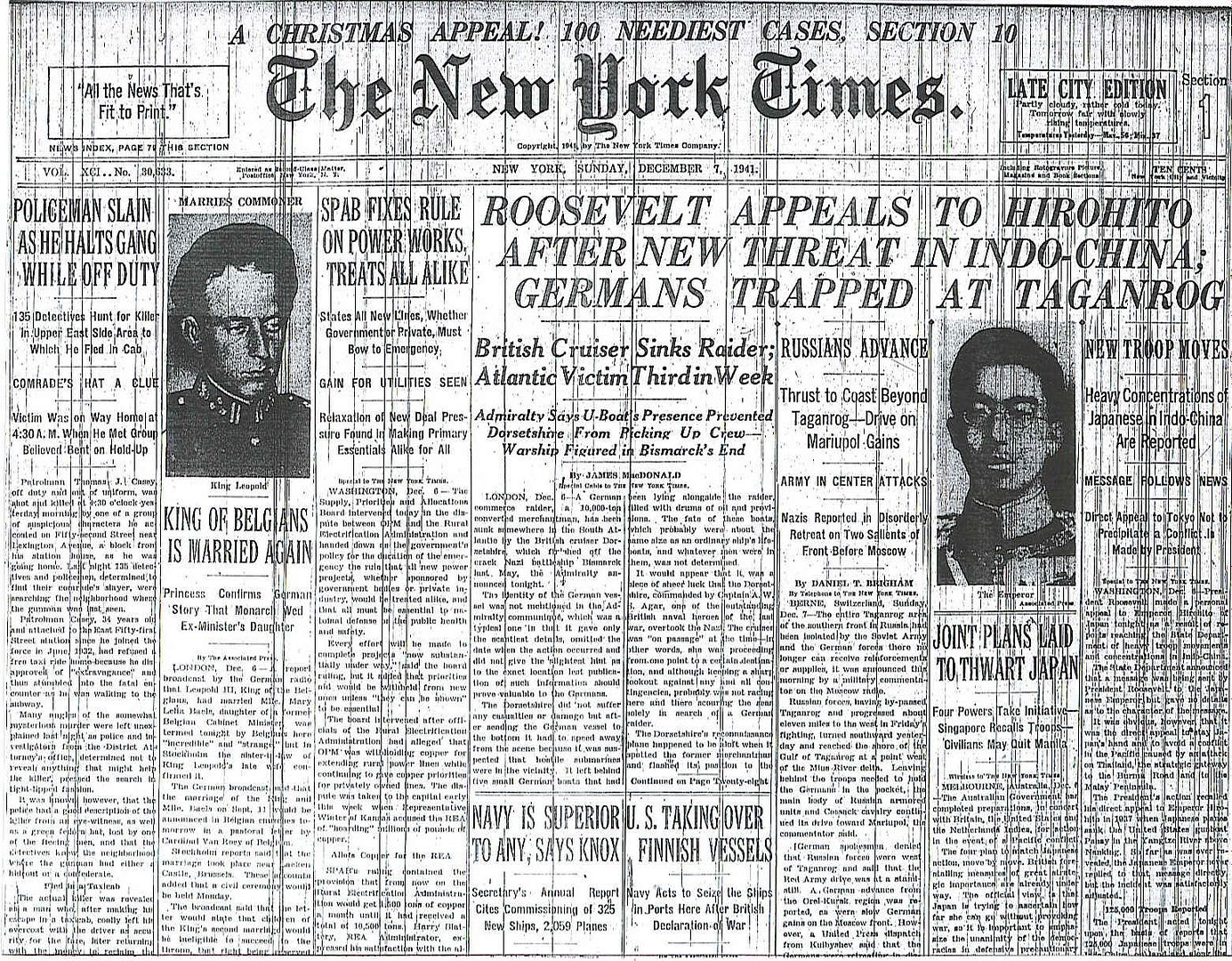
Posted on 12/07/2011 5:35:25 AM PST by Homer_J_Simpson

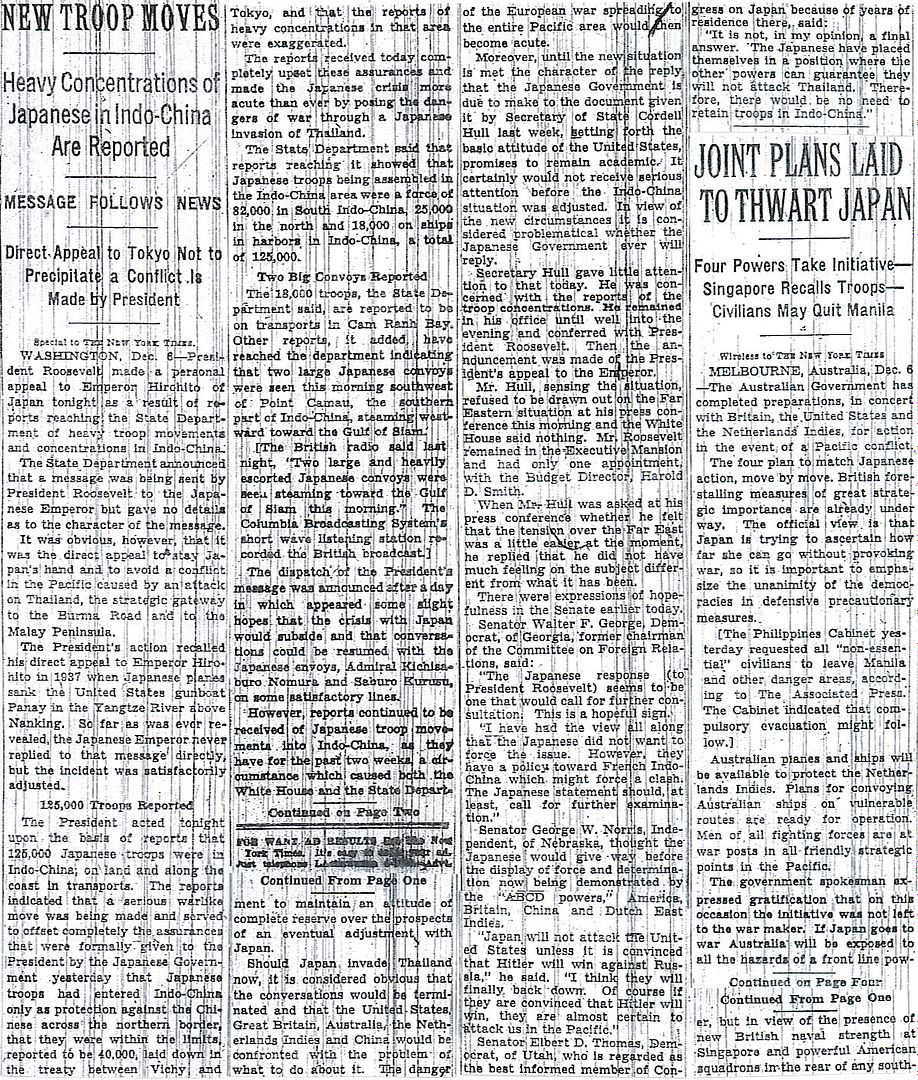

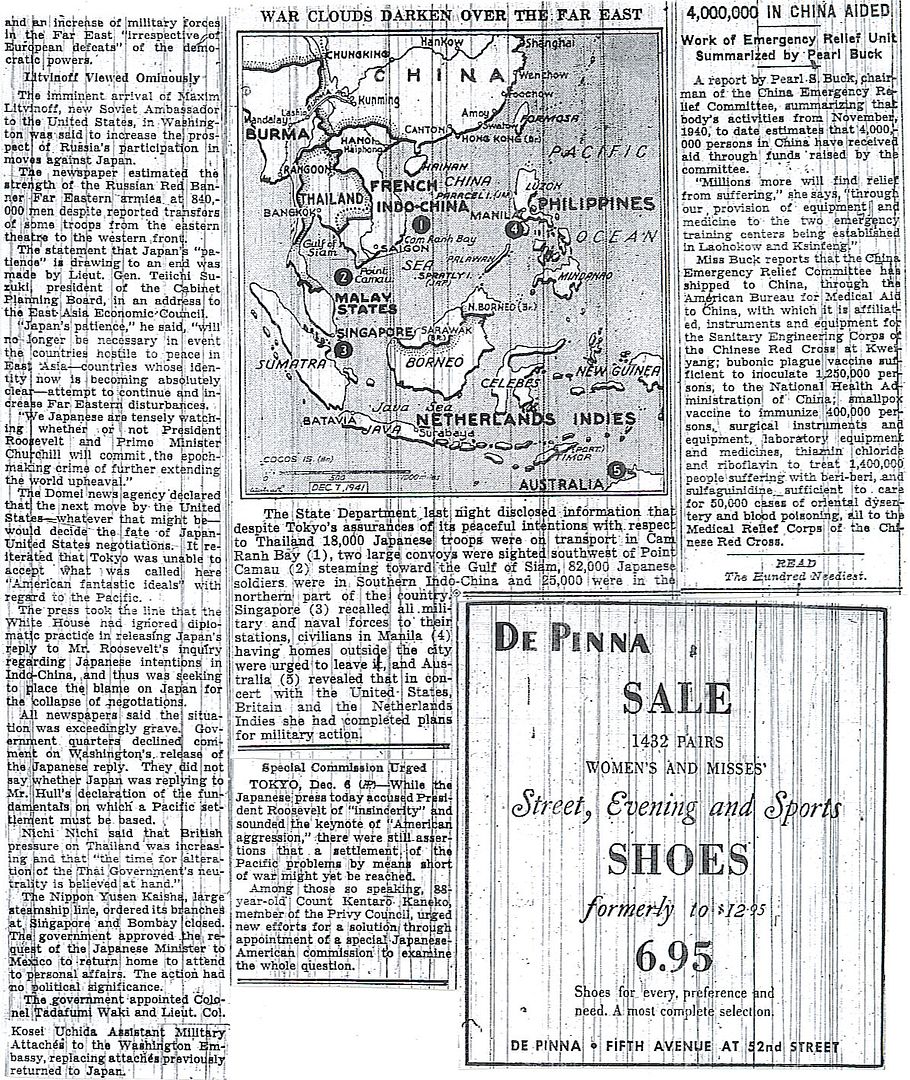
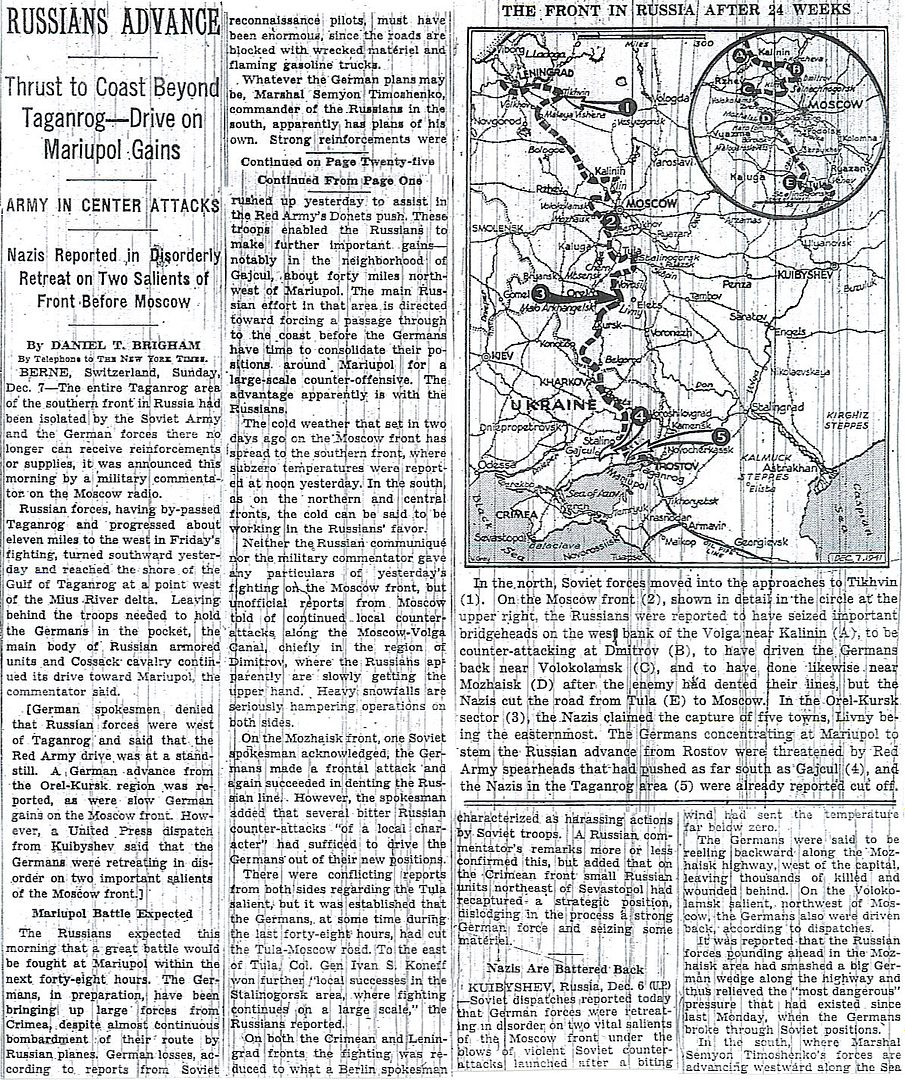
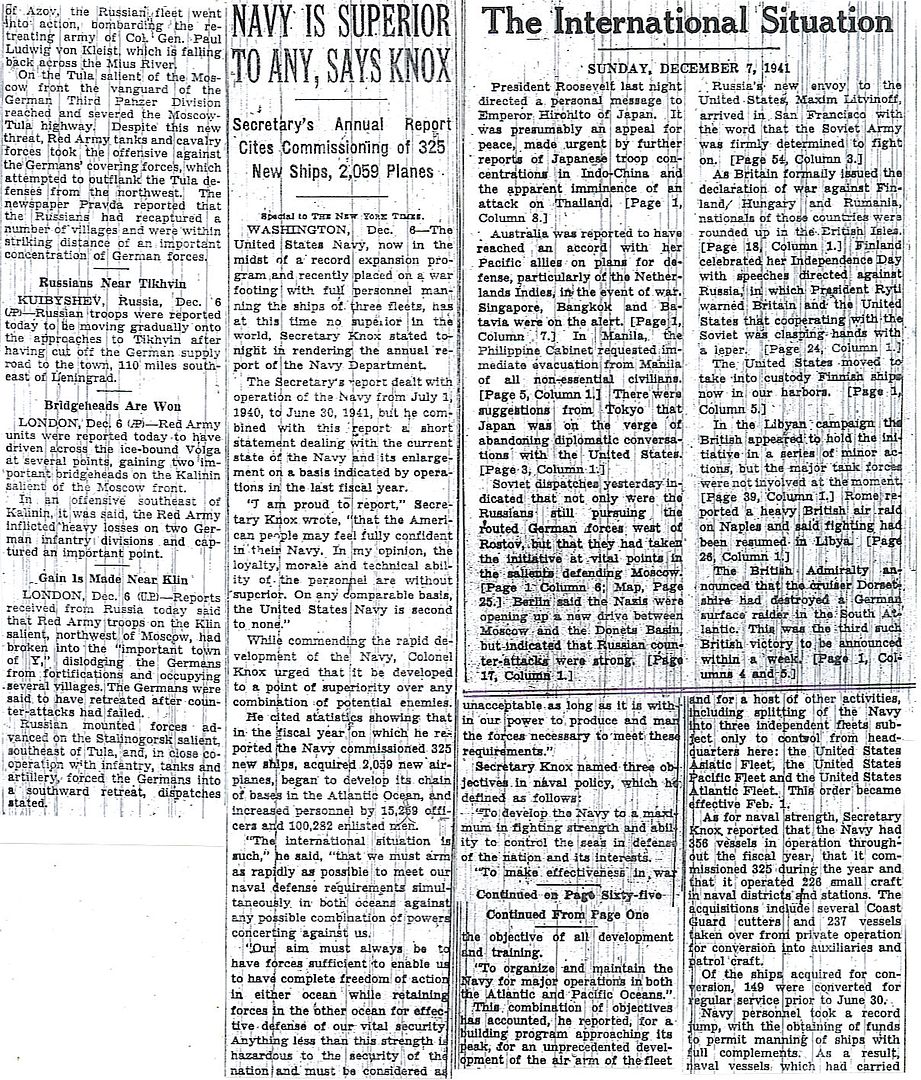
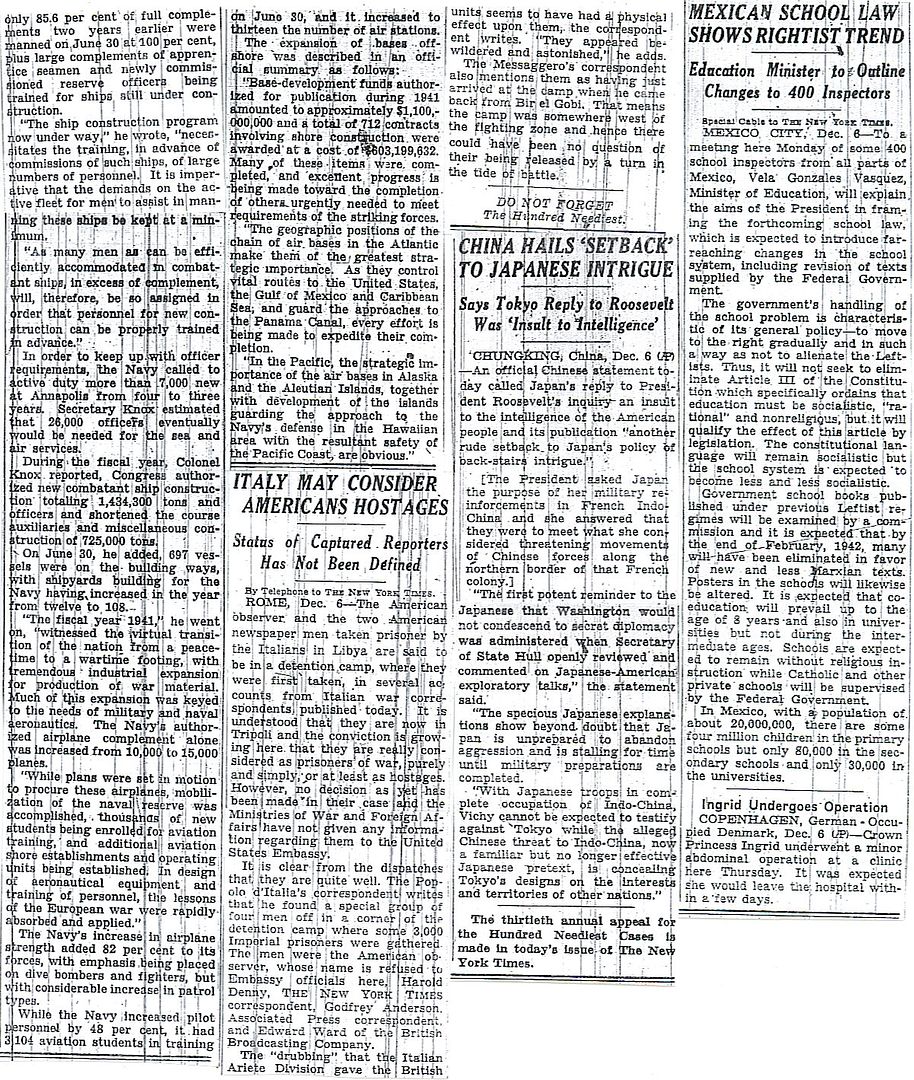


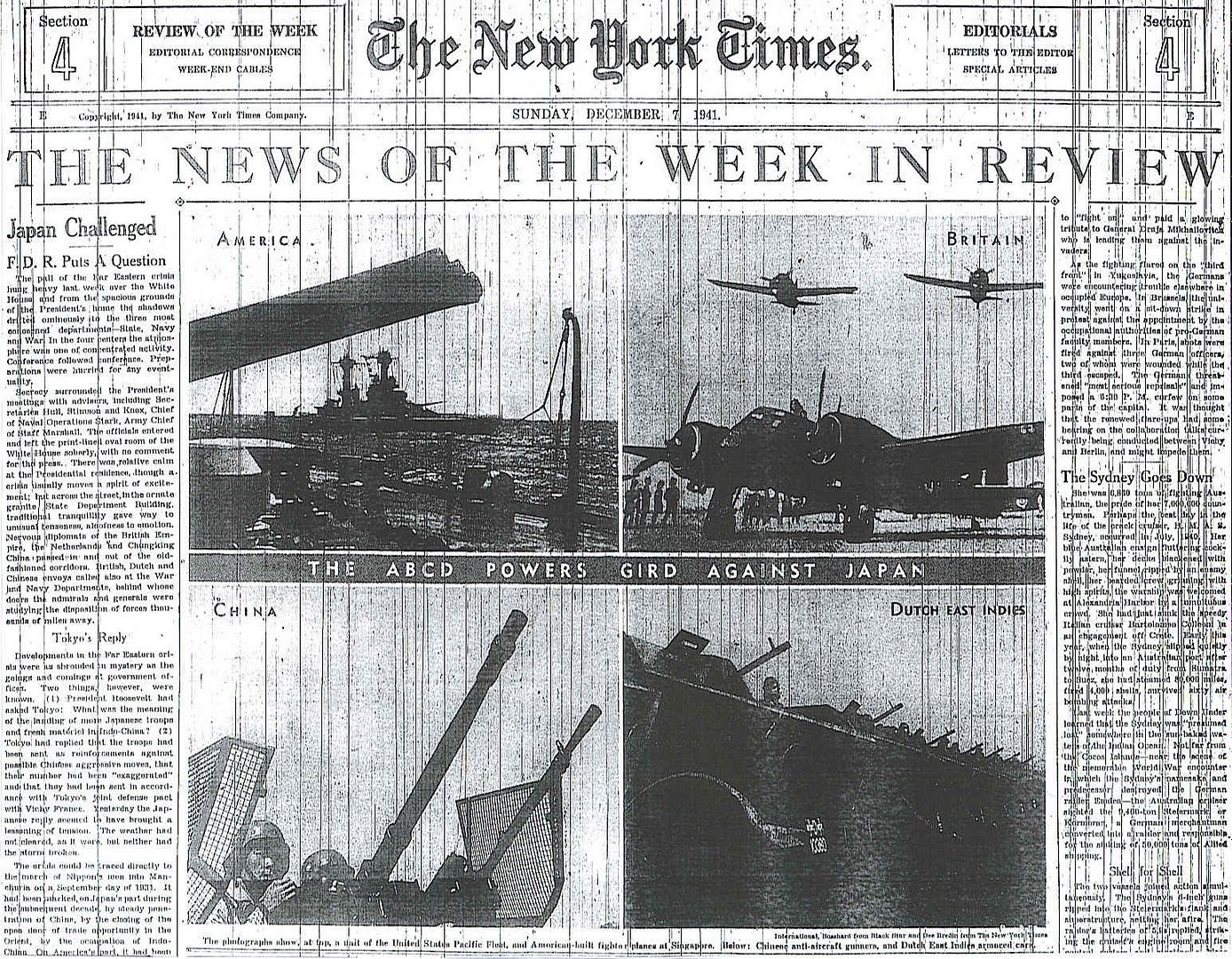
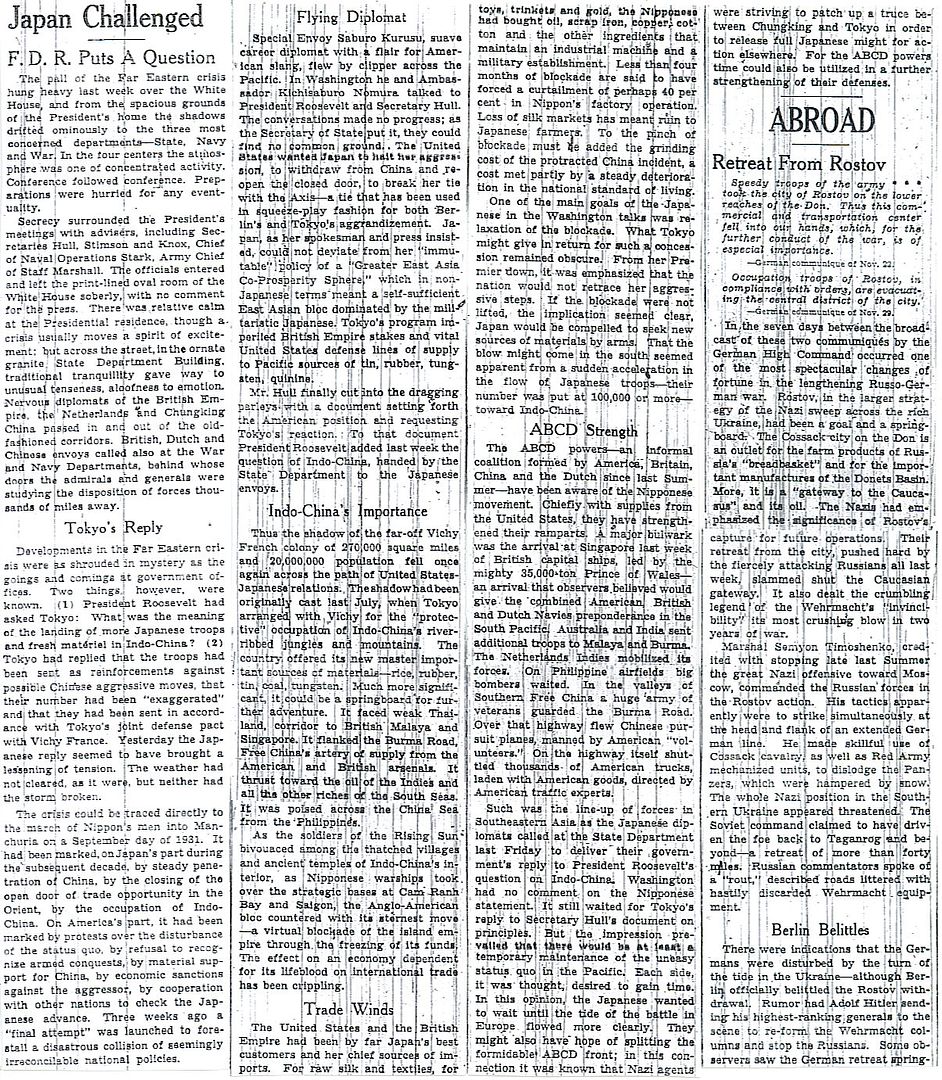
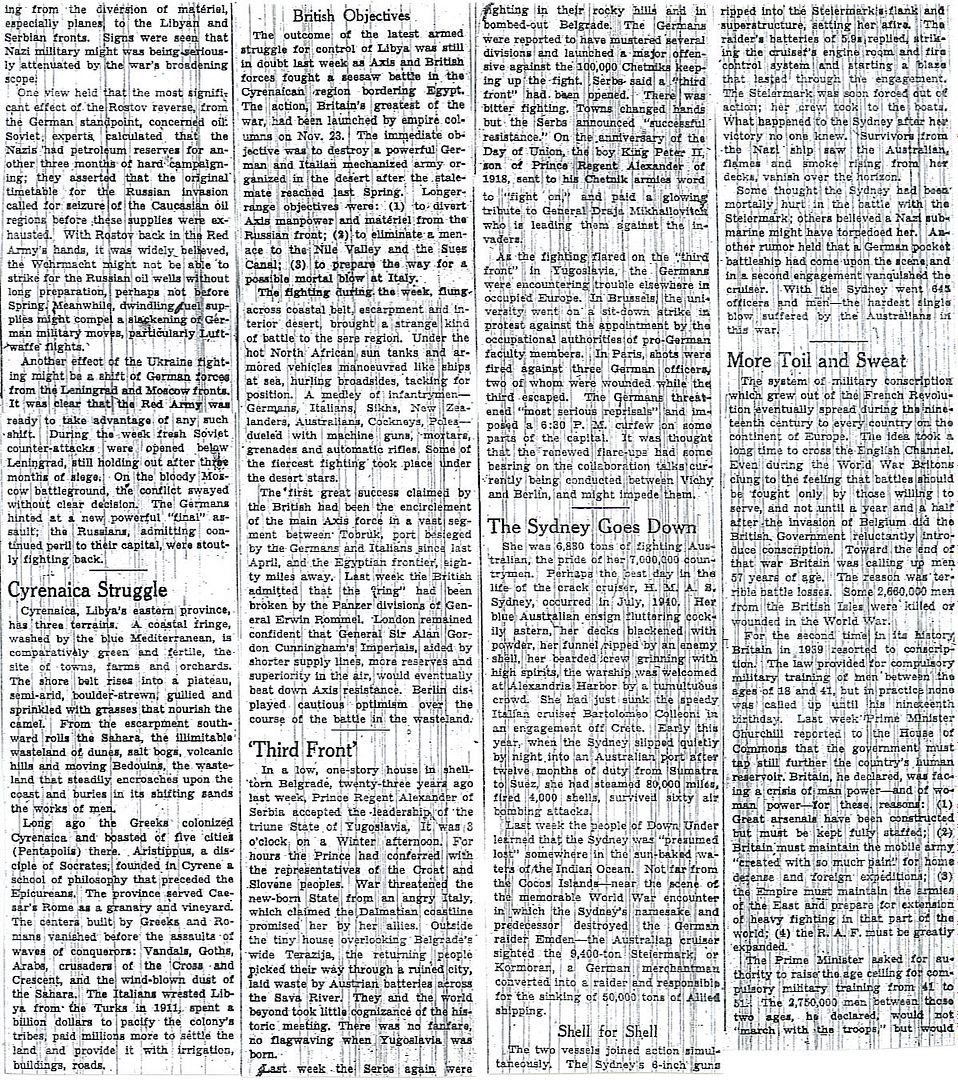
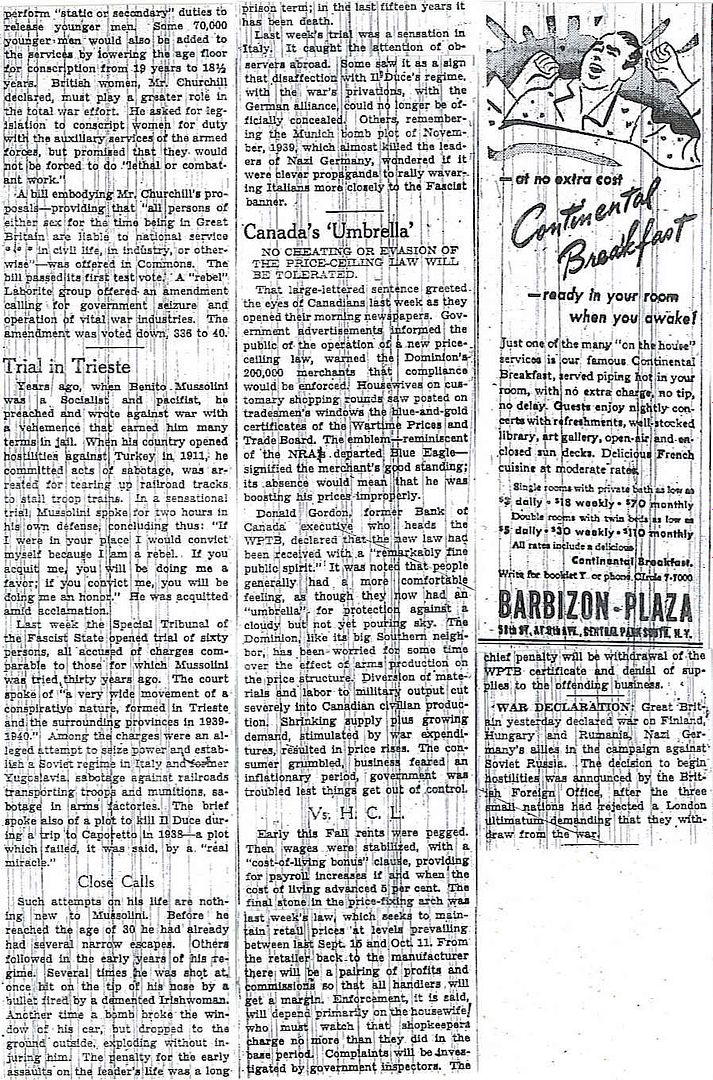
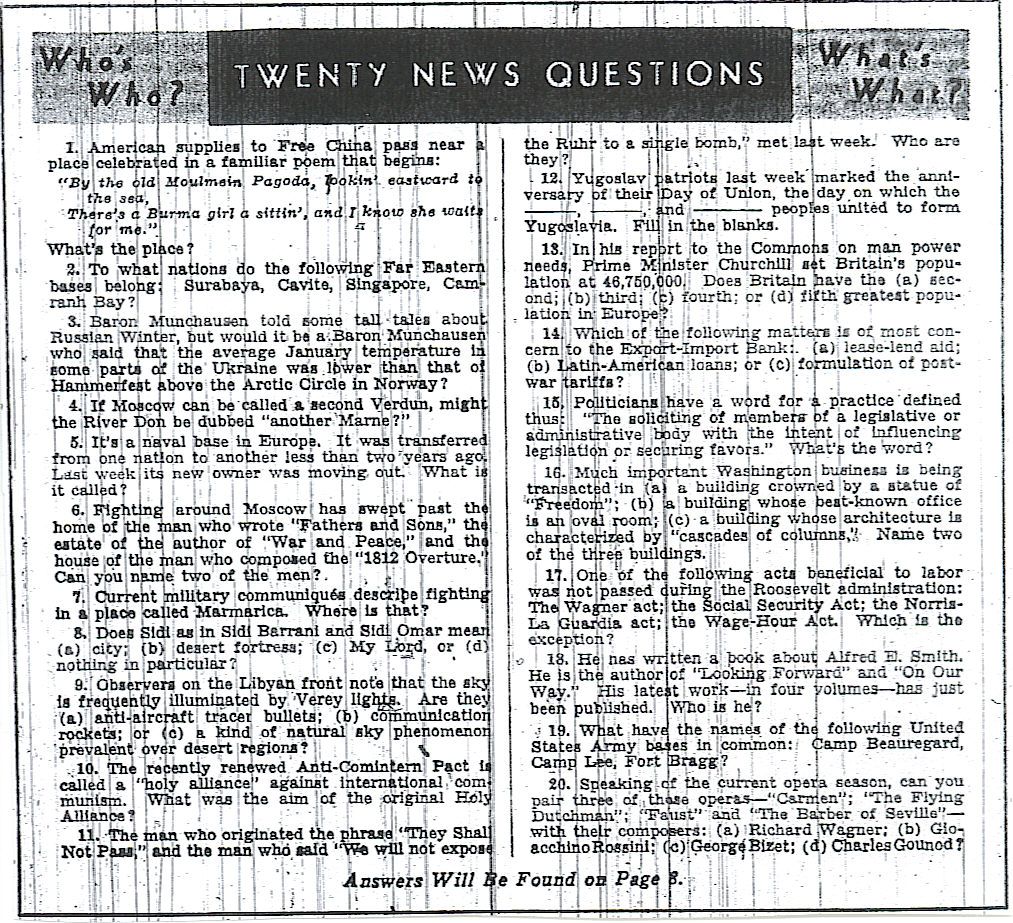
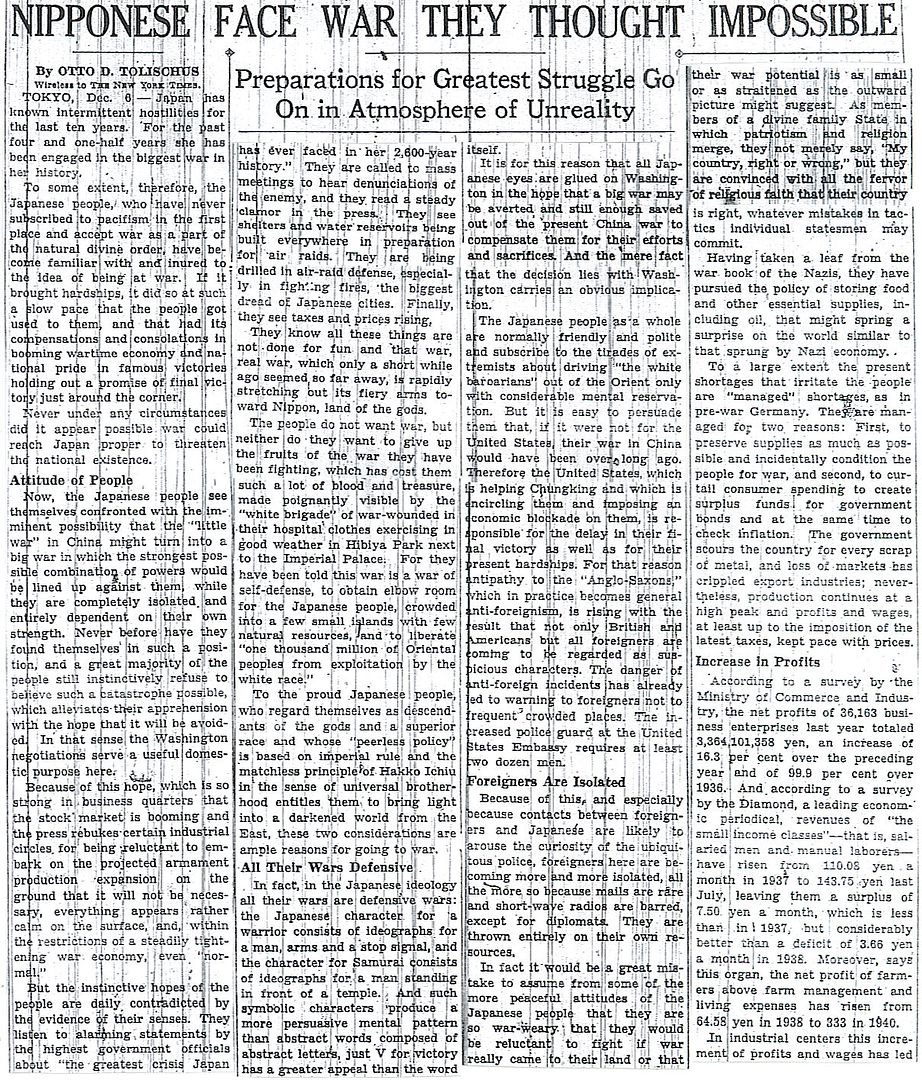

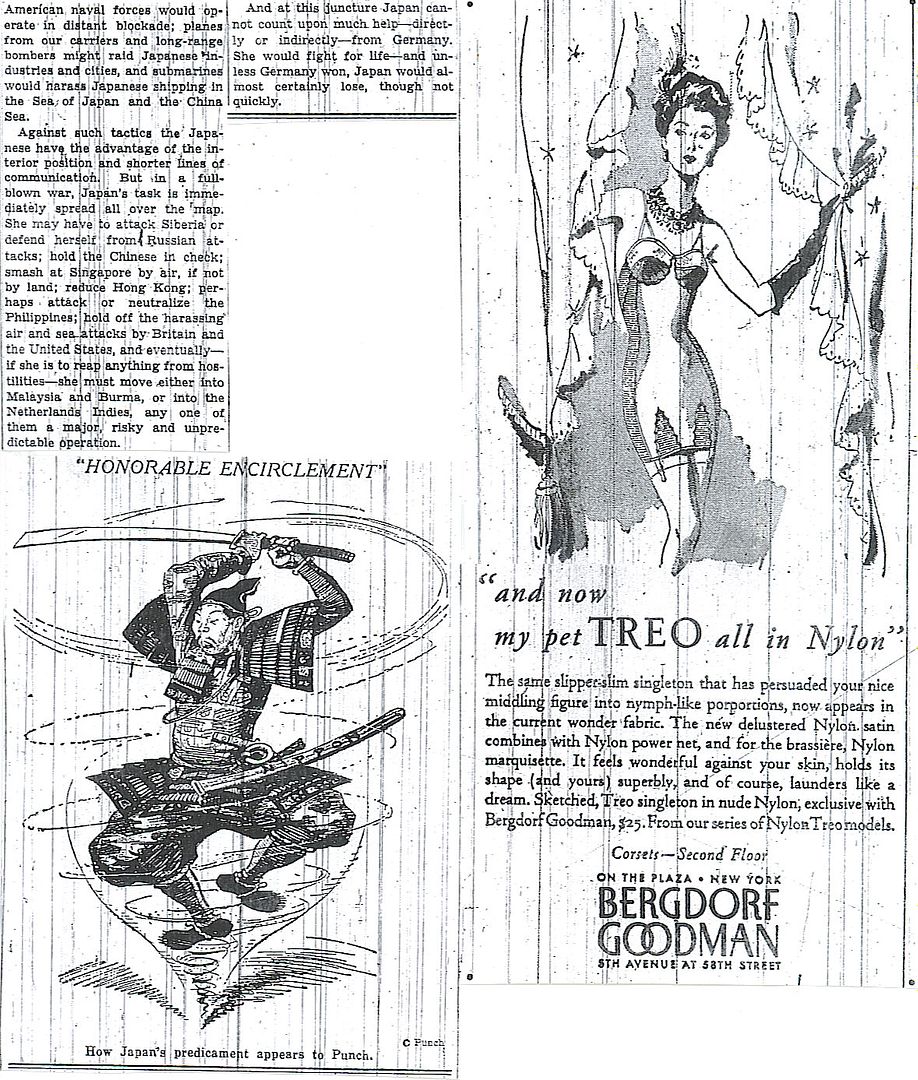
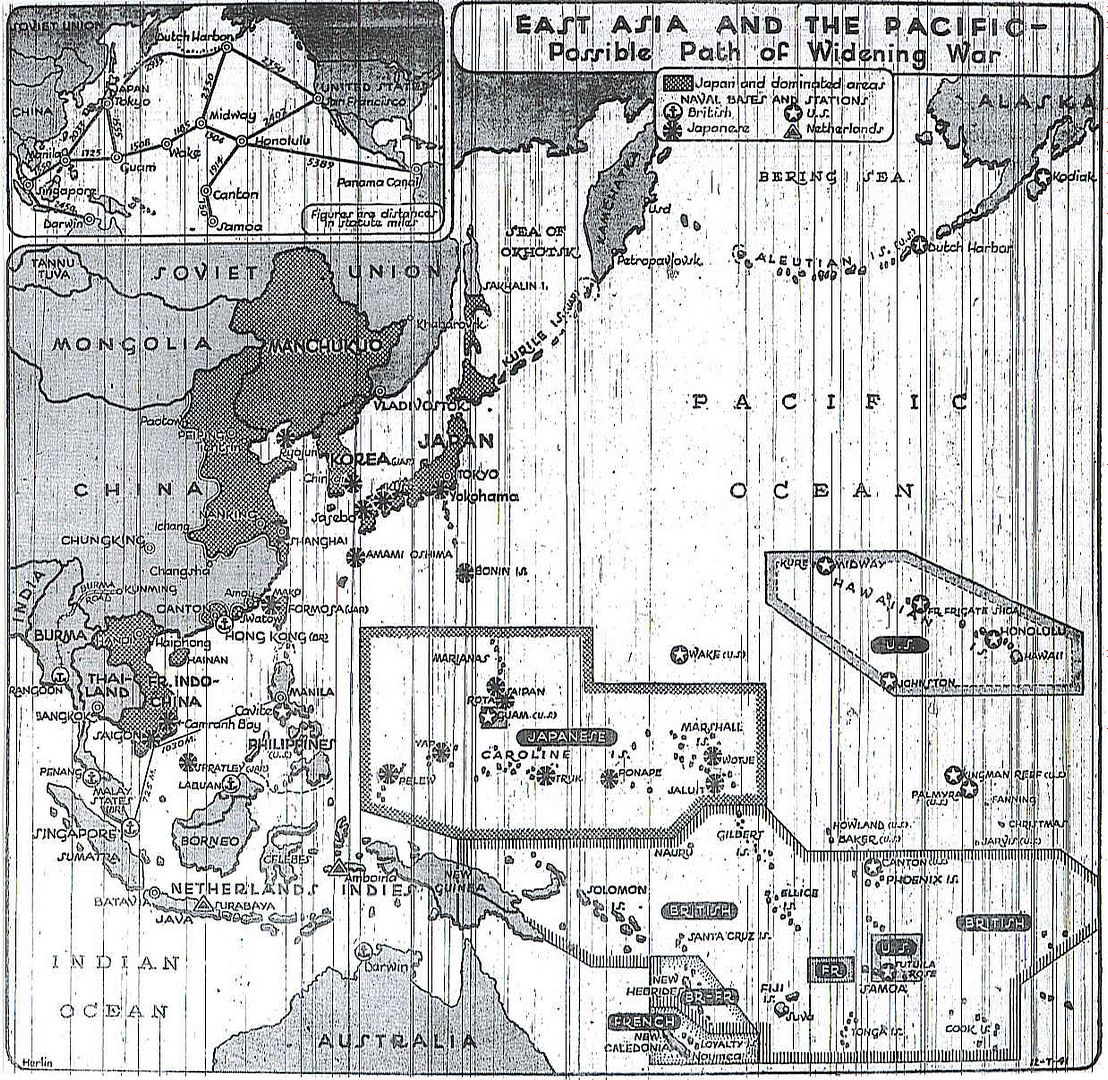
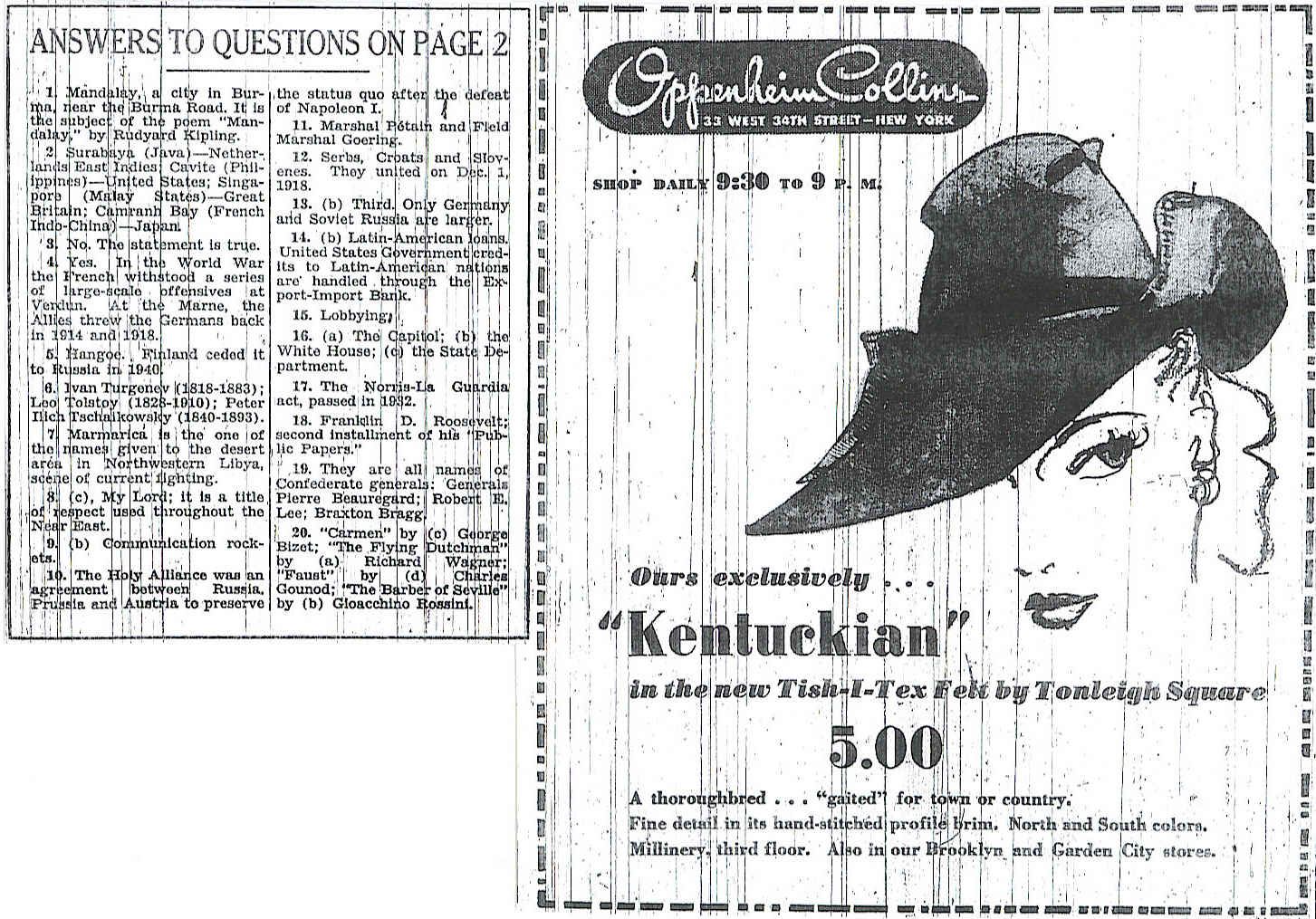
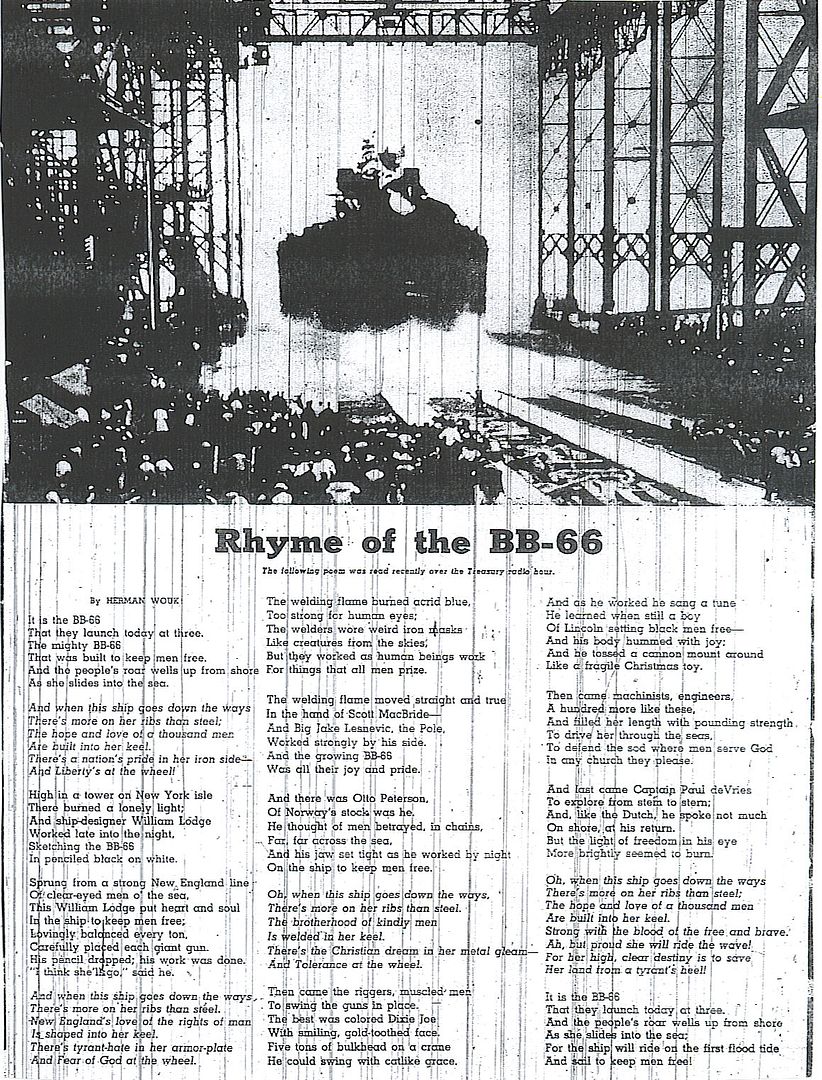
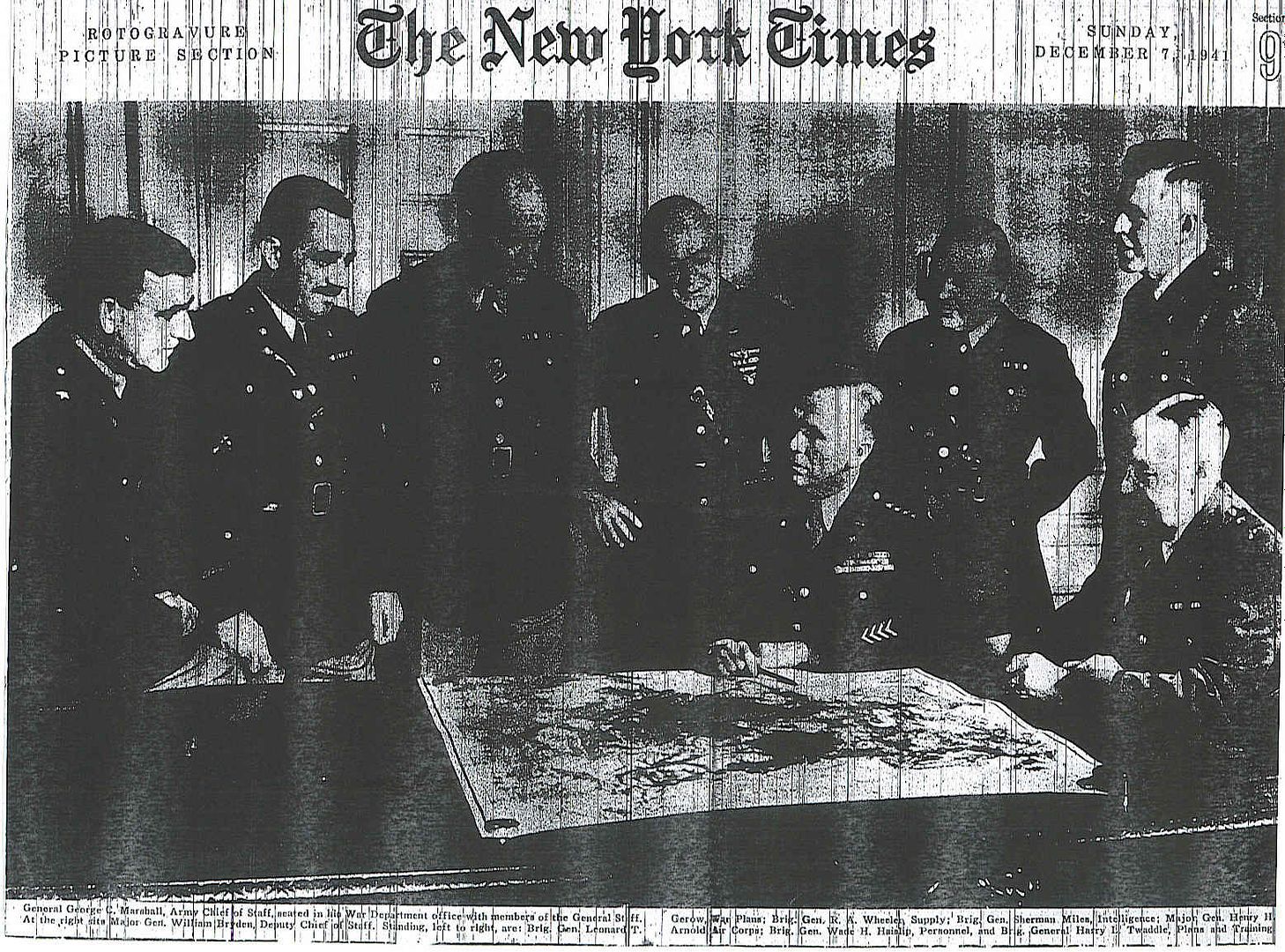
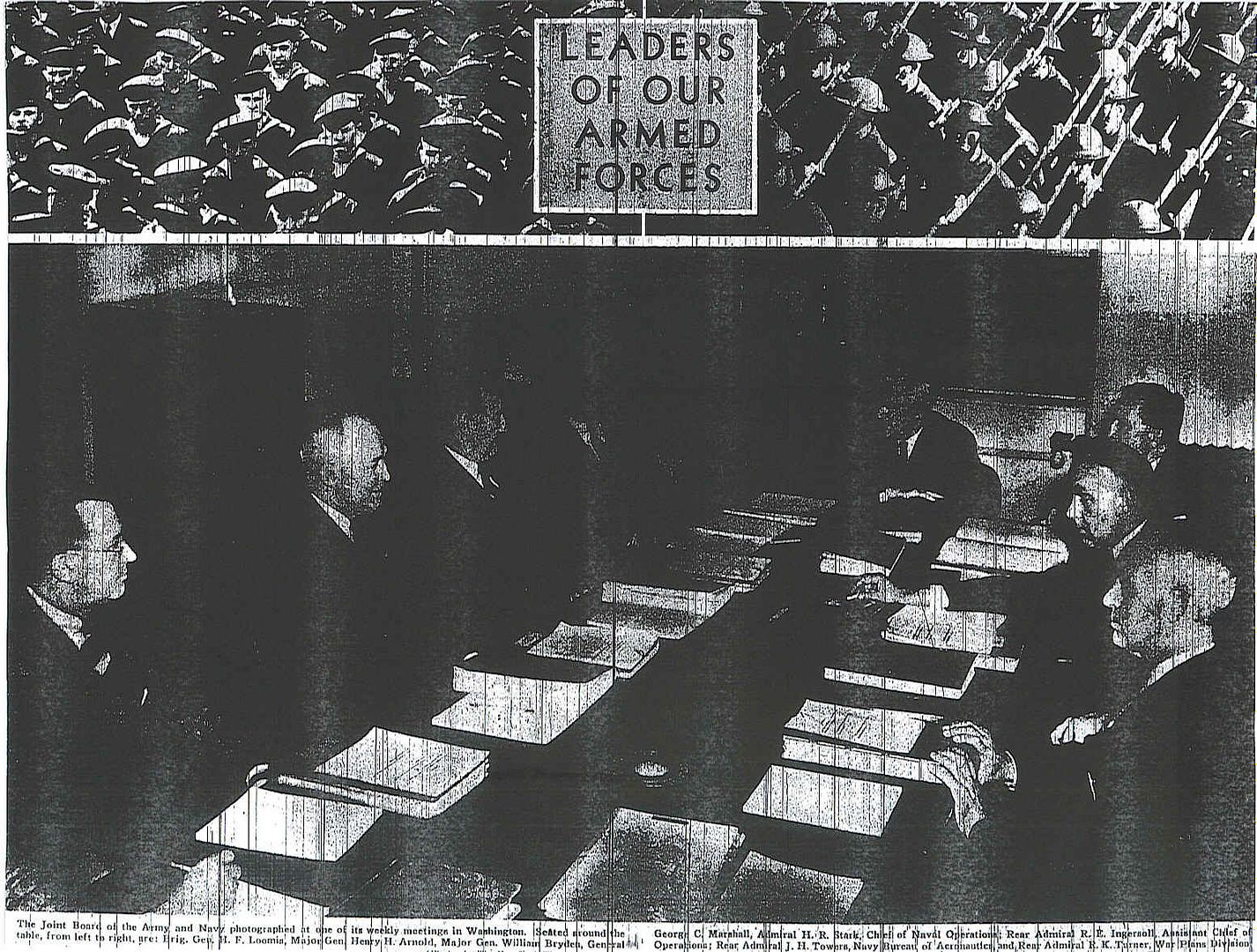
Bump.
The News of the Week in Review
Japan Challenged – 11
Abroad – 11-13
Twenty News Questions – 14
Nipponese Face War They Thought Impossible – 15-16
Big Forces are Massed for Showdown in Pacific – 16-17
East Asia and the Pacific-Possible Path of Widening War (map) – 18
Answers to Twenty News Questions – 19
“Rhyme of the BB-66” (from The New York Times Magazine) *** – 20
Leaders of Our Armed Forces (from the Rotogravure Picture Section) – 21-22
* Update on Harold Denny. If America becomes an official belligerent in the war for some reason these American “hostages” could be in a real fix.
** To Fiji Hill - You are not even on the regular ping lists but you have been right there to root on the Trojans for every game without fail. Who knows whether we will be able to keep up with sports in 1942 and beyond. Right now I am having a hard time keeping ahead of the calendar just with the main news threads. But whatever happens I have enjoyed the football threads and Fiji Hill’s contribution to the project. Oh, and I am glad that USC ends the season with at least a tie. They may not play on New Year's Day this time around but I have a feeling that the Trojans will be back on top in years to come.
So thanks, Fiji, and fight on!
*** I learned something new about Herman Wouk because of this find in the NY Times mag. I didn’t know he ever had any poetry published and I didn’t know he worked for the Treasury Department for awhile. I thought that Wouk (at age 26 in 1941) was still writing comedy for Fred Allen’s radio program. Not so. According to the bio I looked up he quit commercial radio and went to work at Treasury writing promotional material for war bonds. So this poem appeared the year before he became Ensign Wouk, USNR, and went off to the Pacific aboard the minesweeper Zane. It is five years before publication of “Thc Caine Mutiny,” and some 30 years before “The Winds of War – Homer.
http://www.onwar.com/chrono/1941/dec41/f07dec41.htm
Japanese attack Pearl Harbor
Sunday, December 7, 1941 www.onwar.com
Battleships burning at Pearl HarborIn Hawaii... The Japanese attack launched from six carriers, Akagi, Kaga, Hiryu, Soryu, Zuikaku and Shokaku, carrying a total of 423 planes, begins at 0755 local time. Its target: the main base of the US Pacific Fleet at Pearl Harbor. There is complete tactical and strategic surprise. The Japanese task force, under the command of Admiral Nagumo, also contains 2 battleships, 2 heavy cruisers as well as destroyers and support vessels including tankers. Two attacking waves strike the naval base. The first lead by Commander Fuchida is comprised of 40 torpedo bombers carrying special shallow running torpedoes, 51 dive bombers, 50 high level bombers and 43 fighters. The second wave is comprised of similar numbers with more dive bombers replacing the torpedo planes. All eight of the US battleships in port are damaged. The Arizona sinks to the bottom with most hands onboard, the Oklahoma sinks but its later raised and scrapped. The California, Nevada and West Virginia are later rebuilt and rejoin the fleet. Three cruisers and three destroyers are also sunk. The Americans lose 188 aircraft; the Japanese 29. Admiral Nagumo, despite the task forces’s capacity and against advice, does not send a third wave against the base. The three American aircraft carriers serving in the Pacific are not in port and escape unharmed as does much of the infrastructure of the port, including the oil storage tanks. However, the attack leaves the Allies with only the three US carriers and two British battleships as active capital ships in the theater. The cruisers destroyers and submarines available from the Dutch and Free French reduce the numerical inferiority against the Japanese navy, however, the Allied craft are widely dispersed and under multiple commands.
In Washington... The last part of the Japanese signal, stating specifically that relations are being broken is intercepted and decoded by the Americans. Delays in decoding of the message and difficulty in securing an appointment with Secretary Hull ensure that the Japanese delegation do not meet their country’s deadline for presentation of official note breaking of diplomatic ties until after the attack upon Pearl Harbor is launched.
In Tokyo... The British receive official indication from the Japanese three hours later, when their Ambassador in Tokyo is given a copy of the Japanese note. Both the British and US ambassadors in Tokyo are given declarations of war a further three hours later.
In the Pacific... Japanese forces bomb Guam and Wake and Midway is bombarded by Japanese destroyers.
On the Eastern Front... Field Marshal Brauchitsch, citing illness, offers his resignation to Hitler after the successful counterattack. It is not formally accepted but Brauchitsch is removed from important command decisions.
In Ottawa... The Canadian government declares war on Japan.
http://homepage.ntlworld.com/andrew.etherington/month/thismonth/07.htm
December 7th, 1941
FRANCE: Paris: Rue de la Convention. Attack on a Wehrmacht canteen.
GERMANY: The Night-and-Fog Decree (Nacht-und-Nebel Erlass or ‘NuN’) is passed by which any individuals accused of resistance to the occupying power (Germany) can be summarily arrested and deported to a virtual death-sentence at any number of KZ’s in Germany or the occupied territories. (Russ Folsom)
POLAND: Kolo: 700 Jews are deported to nearby Chelmno.
U.S.S.R.: Brauchitsch offers his resignation to Hitler. The stress of the battle on the Eastern Front has taken its toll. Hitler makes no formal acceptance of the resignation, but Brauchitsch makes no important decisions after this date.
JAPAN: 10:30 PM (9:30 AM, December 7. Washington time): Grew receives message for Emperor sent by Roosevelt, delayed in route by Japanese.
CHINA: Japanese occupy the International Settlement at Shanghai. (Dave Shirlaw)
COMMONWEALTH OF THE PHILIPPINES: 9:00 AM (8:00 PM, December 6, Washington time). Navy Department log entry stating Harrison called to request current positions of all USN and RN ships. Harrison later denied making this call. (This may have been in preparation for the planned meeting with Roosevelt at 3 PM on December 7.)
5:00 PM: Unidentified aircraft spotted over Clark.
9:00 PM until 2:00 AM December 8 (8:00 AM to 1:00 PM Washington time): Advance Party of 27th B.G. — an incoming unit of A-24 attack bombers — throws party in honour of Brereton at Manila Hotel. Hart and Purnell are present for first part.
9:30 PM (8:30 AM Washington time): Brereton telephones FEAF HQ at Neilson Field from Manila Hotel to order that FEAF and all fields and subordinate commands were to go on “combat alert” at daylight. Order was never carried out.
TERRITORY OF HAWAII:
Attack on Pearl Harbor. Articles courtesy of Jack McKillop and Marc Small. Extra Articles Here
Japan launches air attacks on Pearl Harbor, Guam and Wake Island; its navy bombards Midway Island.
Honolulu: The message was simple and stark:
“AIR RAID, PEARL HARBOR.
THIS IS NO DRILL.”
Japan’s devastating opening blow of the Pacific war against the United States came plunging out of a sunny Hawaiian sky yesterday when 184 aircraft from six Japanese aircraft carriers of Vice-Admiral Chuichi Nagumo’s Strike Force caught the American defenders completely unawares at Pearl Harbor, Oahu, at 7.55am [local time].
Japanese spies had reported that the Pacific Fleet was almost certain to be in Pearl Harbor on a Sunday morning. They were right. 86 warships of the fleet were spread out before the eager eyes of the Japanese pilots. They included seven battleships - the prime targets in the absence of carriers - moored close to each other in “Battleship Row”, and another the USS PENNSYLVANIA, in dry dock.
This audacious operation, designed to neutralize the Pacific Fleet in one blow, succeeded in sinking four battleships in a total of 19 warships sunk or disabled. It destroyed 188 military aircraft and damaged 159, and killed 2,403 Americans, 1,000 of them in the battleship USS ARIZONA which blew up and sank at her mooring early in the attack. For the battle force of the US Pacific Fleet it was the hour of doom.
Japanese losses were light. Only 29 Japanese aircraft failed to make it back to the carriers, and one Japanese I-class submarine and five midget submarines were sunk.
Such a spectacular victory on the first day of war has no parallel in the history of warfare. In Washington today, President Roosevelt described the Japanese action as “a day that will live in infamy.”
The six Japanese carriers, AKAGI, KAGI, Hiryu, SORYU, ZUIKAKU and SHOKAKU, had met in late November at Tankan Bay in the Kuriles and with naval escort, approached in great secrecy to the flying off position 275 miles north of Hawaii.
The first attacking wave comprised 50 high-level bombers, 40 planes carrying shallow-running torpedoes, 51 dive-bombers and 43 Zero fighters. Their approach was detected by army radar at a distance of 132 miles, but they were thought to be friendly planes.
By 7.40am the Japanese strike force was over Oahu, and 15 minutes later the attack began with dive-bombers blasting the army, navy and marine airfields to neutralize American air power so that the attack on warships could proceed without interference.
The torpedo planes, high-level and dive-bombers attacked the warships initially without any opposition whatever. Amid the roar of engines and the crash of bombs, they turned Pearl Harbor into a smoke-filled inferno of blazing, exploding warships and installations.
At 8.30am a lull developed, but within 45 minutes a second strike force of 176 planes launched its attack. They withdrew by 10am and the raid was over. The big disappointment for the Japanese was the absence of the aircraft carriers of the Pacific Fleet which were on manoeuvres at the time of the raid. By this action alone, the Japanese have proved the value of big carriers in any naval campaign.
At 0645 hours local, the old Wickes Class four-stack destroyer USS Ward (DD-139) opened fire with her Number 1 4-inch gun on a Japanese midget submarine attempting to enter Pearl Harbor; the shell splashed harmlessly beyond the small conning tower. Then number three 4-incher atop the galley deckhouse amidships commenced fire and its round passed squarely through the submersible’s conning tower. As the Japanese midget submarine wallowed lower in the water and started to sink, the destroyer swiftly dropped four depth charges which sink the sub.
Seaman First Class James Richard Ward, US Navy, wins the MOH for conspicuous devotion to duty, extraordinary courage and complete disregard of his life, above and beyond the call of duty, during the attack on the Fleet in Pearl Harbor by Japanese forces on 7 December 1941. When it was seen that the U.S.S. Oklahoma was going to capsize and the order was given to abandon ship, Ward remained in a turret holding a flashlight so the remainder of the turret crew could see to escape, thereby sacrificing his own life. (Drew Halevy sent me the above citation)
Captain Mervyn Sharp Bennion, US Navy, displays conspicuous devotion to duty, extraordinary courage and complete disregard for his own life, above and beyond the call of duty. As commanding officer of the USS West Virginia, after being mortally wounded, Capt. Bennion evidenced apparent concern only in fighting and saving his ship, and strongly protested against being carried from the bridge. (MOH)
USCGC Taney’s screen of anti-aircraft fire prevented Japanese planes bombing Pearl Harbor from destroying Honolulu power plant. (Dave Shirlaw)
Two B-17Ds took off from Hickam Field, Territory of Hawaii at 1140 hours to look for the Japanese fleet. (Jack McKillop)
The newly federalized Hawaii Territorial Guard (HTG), made up of ROTC cadets and volunteers from Honolulu high schools, the majority Nisei, is placed under direct Army command. (Gene Hanson)
Remembrances of our List Vets on “Where was I when ...”:
I was sitting at the bar of the Brown Palace Hotel in Denver, Colorado. The bartender came up to me and said, “Soldier you better get back to your base. The Japanese just bombed Pearl Harbor and all military people are ordered back”
I hitch hiked back to base. What a contrast! Hitching rides into Denver that day I waited 30 minutes for a car to stop. Going back, the first car I stuck my thumb out at screeched to a stop and drove me right up to the gate! (Hal Turrell)
I had just come off watch in the ops room at RAF Portreath, Cornwall, England, in 10 Gp Fighter Command, and the Spits were ready for a dawn ‘Rhubarb’ (low-level nuisance raid against opportunity targets). It was very cold and wet with a thick sea mist and the mud was vile. As I took off my boots I turned on the radio. The news of the attack was shocking, but I knew then that the hope of our winning the war was now a certainty as the USA was bound to come in. It was an ill wind that looked as if it would blow us good in the end. (Doug Tidy)
It was 8th of December in Burma and my Squadron was in Keydaw, just a few miles north of Toungoo ( this place is still on the maps) and the war came to the AVG in the form of an air raid siren going off in the middle of the night. Scared the hell out of us uninitiated heroes as we were informed that we may have a visit from Japanese paratroopers and this caused some palpitations and shrinking gonads among us stalwarts of democracy and saviors to the Chinese. We got right busy after the initial shock and carried on our normal activities.
I soon after learned that you were not immortal even at 21.
(Chuck Baisden)
U.S.A.: The New York Times reports this morning.
BIG FORCES ARE MASSED FOR SHOWDOWN IN PACIFIC
Japan Would Have to Meet Superior Strength of the ABCD Powers
By HANSON W. BALDWIN
Men stood to arms along the shores and upon the islands of the Western Pacific yesterday as the storm of war, roaring eastward out of Europe, clouded the skies of the Orient.
The American-Japanese negotiations, stalemated at the week-end but prolonged in the hope of eventual compromise as both sides sought for time, were perhaps a less important index to the seriousness of the Pacific situation than the actual military forces in the theatre of potential struggle.
The land, sea and air forces now mobilized in the Pacific are very considerable, not by any means as large as the great armies struggling in Russia or the fleets and air forces deployed around the periphery of the continent of Europe, but nevertheless more considerable than any the Orient has hitherto known. They include:
Japan
The Japanese Army consists of perhaps sixty to sixty-six divisions (part of them “triangular” divisions of 16,000 to 17,000 men; the rest, “square” divisions of 22,000 men), a grand total of about 1,800,-000 men. The exact disposition of these troops is not known, but probably more than twenty divisions are locked up in the unending struggle with China; another twenty to twenty-seven may be in Manchukuo opposite the Russian Far Eastern armies; there are forces in Metropolitan Japan and garrisons in her island outposts; there are possibly 75,000 to 150,000 troops today in French Indo-China and several other divisions in Hainan Island, on the high seas or on the island of Formosa.
Perhaps 1,000 of Japan’s 3,000 to 5,000 tactical planes are in China; there are undoubtedly several hundred in French Indo-China; the others may be scattered from Metropolitan Japan and Paramshir and Sakhalin to Formosa. Japan possibly has one new battleship in commission, of about 40,000 tons with sixteen-inch guns, giving her a total of eleven capital ships, with a twelfth nearly ready. She has at least seven, possibly nine, aircraft carriers converted from merchantmen, a number of seaplane carriers, and large squadrons of cruisers, destroyers and submarines. There may be one or two big, heavily armored new battle cruisers or “pocket battleships” In commission.
The United States
Approximately 50 per cent of United States naval strength was In the Pacific at last report, with the bulk of our hitting power concentrated in the Pacific Fleet based on Hawaii. The Asiatic Fleet, a separate entity, consisted some months ago of three cruisers, a squadron of destroyers, eighteen submarines, some twenty-four long-range patrol bombers and various auxiliaries. It has probably been strengthened in recent months, but it is still primarily a defensive torpedo fleet, which is to be assisted in its task by air power.
The Philippines have been heavily strengthened, both with land and air forcees, and Lieut. Gen. Douglas MacArthur has now assumed direct command of United States armed forces in the Far East, with Regular Army troops and 150,000 Filipinos under his orders.
Hawaii is a great fortress, more heavily garrisoned, land, sea and air, than ever in its history, and bases in Alaska, Midway, Wake and many other mid-Pacific islands are being completed and garrisoned.
Great Britain
At Singapore Britain has recently stationed two capital ships to compensate for our Pacific weakness—resulting from transfers to the Atlantic—in this category, and there are cruisers, probably aircraft carriers and some smaller vessels.
There are probably 10,000 or more men in Hong Kong and perhaps a few British submarines, but almost no planes. There may now be 70,000 to 150,000 men in Malaya, with several hundreds of planes, and an unknown garrison in Burma, probably small on land, but considerable in the air. In addition India, Australia and New Zealand provide a large backlog of strength.
Russia
Russia has drawn upon her Far Eastern Forces to reinforce her hard-pressed armies in the West, but, nevertheless, it is likely that more than twenty divisions still are stationed in Eastern Siberia, with some tanks and a considerable number (several hundred) of planes.
China
China has a large, though badly equipped, army of guerrillas and regulars, variously estimated at from 2,000,000 to 6,000,000 men, and perhaps 100 Curtiss P–40 pursuit planes with American volunteer pilots may shortly be ready to help General Chiang Kai-shek defend the Burma Road.
Netherlands Indies
A naval force that admirably supplements the British Far Eastern forces, consisting of about three cruisers, eight destroyers, forty torpedo boats and some fifteen submarines, is supplemented by an increasingly powerful bomber force, which may now consist of 200 to 300 bombers, plus a considerable number of long-range naval patrol planes, and 200 or so fighters (nearly all American-built planes). The Netherlands Indies Army probably numbers more than 100,000, mostly natives, and is fairly well equipped.
Thailand.
An army of perhaps 80.000 men —most of them already mobilized —with numerous reserves but little equipment. Air force negligible.
Such are the forces most immediately concerned by the situation in the Pacific. The equation of uncertainty that any Pacific struggle would entail is rendered more complex by the great distances in that ocean.
The general strategy of a Pacific war would be one in which air power and sea power, acting primarily as weapons of economic attrition, would play large roles. From Hawaii and Singapore and the Netherlands Indies Anglo-American naval forces would operate in distant blockade; planes from our carriers and long-range bombers might raid Japanese industries and cities, and submarines would harass Japanese shipping in the Sea of Japan and the China Sea.
Against such tactics the Japanese have the advantage of the interior position and shorter lines of communication. But in a fullblown war, Japan’s task is immediately spread all over the map. She may have to attack Siberia or defend herself from Russian attacks; hold the Chinese in check; smash at Singapore by air, if not by land; reduce Hong Kong; perhaps attack or neutralize the Philippines; hold off the harassing air and sea attacks by Britain and the United States, and eventually— if she is to reap anything from hostilities—she must move either into Malaysia and Burma, or into the Netherlands Indies, any one of them a major, risky and unpredictable operation.
And at this juncture Japan cannot count upon much help—directly or indirectly—from Germany. She would fight for life—and unless Germany won, Japan would almost certainly lose, though not quickly.
In a scheduled baseball game, the Paramount Pictures team is playing the Japanese-American Los Angeles Nippons. The Japanese attack on Pearl Harbor is announced in the third inning but the game continues with Paramount wining 6-3. (Jack McKillop)
10:00 AM (9:00 PM, December
11:00 AM: (10:00 PM, December 6, Washington time): copies of first 13 parts of Japanese message on negotiations delivered to Roosevelt, Knox, Turner, the Director of Naval Intelligence, Rear Admiral Theodore S Wilkinson, and to the Director of Army Intelligence, Brigadier General Sherman Miles.[1]
[1]General Miles was the son of Lieutenant General Nelson Miles and the nephew of General William Tecumseh Sherman.
MIDWAY ISLAND: Two destroyers of the Japanese Midway Neutralization Unit shell Sand Island. (Gordon Rottman)
ATLANTIC OCEAN: Corvette HMCS Windflower rammed and sunk in convoy SC.58 by Dutch freighter Zypenhberg C/S “PIZW”, in dense fog off the Grand Banks at 46 19N 49 30W. 23 crewmembers lost. Windflower was cut down in thick fog by the bow of the freighter. One of her boilers blew up and within 10 minutes she was sinking. Her starboard lifeboat was thrown overboard by the force of the explosion, dragging along several of the men who had been attempting to launch it. As live steam from the exploded boiler seethed up through the fog the men remaining on board got away the port lifeboat and one carley float. Windflower’s stern went under, her fore part rose out of the water and leaned perilously over the men close alongside. Some of those on the float, seeing the looming shape above them, prepared to abandon their refuge for the water, where they would almost certainly have drowned. A Petty Officer calling upon all his stock of authority and the mighty resources of a naval vocabulary kept them in their places while the bow leaned off in the other direction and sank slowly from sight. HMS Nasturtium returned to join with Zypenhberg in rescuing 47 of Windflower’s company, three of whom died later. Convoy SC-58 (49-ships in ten columns) sailed from Sydney, NS, on 04 Dec. An eight-ship mid-ocean escort group (Lt. H.S. Rayner in St Laurent, Senior Officer), relieved the local escort group on 06 Dec. Windflower was stationed on the starboard bow of the convoy but lost contact with the main body in heavy fog. The OOW reversed course and was closing to resume station when she was sighted by Zypenhberg crossing her bow from right to left at a distance of 400 yards. Zypenhberg, Capt Bakker, Master, which was the fourth in the starboard column of five ships, went full astern and began sound signals to warn the next ship astern, Baltara (3,300 GRT). Windflower went to full ahead and altered to starboard but was struck on the port quarter and lost 25 feet of her stern. For a time it appeared that the ship could be saved but the after bulkhead finally gave away and caused the boiler to explode, which was the main cause of the casualties. HMS Nasturtium, hearing the explosion, assumed that the convoy was under attack and closed the area, carrying out a depth charge attack on an Asdic contact that was actually the sinking Windflower. In the process she seriously damaged herself although no casualties were inflicted on the 47 Windflower survivors that were recovered by Zypenhberg. Zypenhberg and Nasturtium were detached to St. John’s while the remainder of the convoy continued. Four days later a strong gale scattered the formation but there was fortunately no contact with the enemy and the ships arrived safely in Liverpool on 21 Dec 41. (Alex Gordon and Dave Shirlaw)(108)
Thanks very much for the postings. I especially like looking to see if there is a “labor” article. Today is the first day in week without one, I think (perhaps the Times knew something?). Imagine...the world is going to hell in a hand basket, but the only thing on the mind of the union bosses is how to stick it to “the man”. And even after today, FDR had a real fight to get these jerks to load our ships.
...and people wonder why I have a problem with unions.

What is with that BB 66 ryme? BB-66 was not evens started for 3 more years. It is not a 56 which was launched earlier this year. As far as I can tell no battleships were lanched anywhere near this time.

seems like more turbulent news outta the Far East, but just another peaceful Sunday for the USA....
So, anyone else here confident about the President’s personal letter to the Emperor?
Slow news day.
As I recall the Wasp was on a shakedown cruise in the Caribbean that morning.
My guess is Wouk was making a statement about defense spending in general and didn't want to single out a particular project. Maybe he picked 66 as a number we couldn't possibly reach in the foreseeable future. As far as recent launchings, we saw that of Indiana a few weeks ago.
The first American prisoners of the Japanese were taken that same morning...the Peking Legation garrison of US Marines at Peking and Tientsin, along with a handful of Naval personnel who remained behind after the Yangtze River Patrol forces departed for Corregidor at the end of November.
That Bruin quarterback Bob Waterfield is a fantastic passer. It's a safe bet that he has a bright future in the NFL. Our own quarterback Bobby Robertson is also likely to join the pros.
I noticed that USC president Rufus von Kleinsmid has said that coach Sam Barry will be with the Trojans for a long time. We shall see. In any case, I hope von Kleinsmid will be with us for a long time. He has done a fantastic job in transforming USC into a world-class university. Perhaps someday, they will name a building on campus after him--I suggest that it be the School of International Relations, because von Kleinsmid was such a strong supporter of establishing such a school.
Well, it's Sunday morning, December 7, 1941. Time to go out and get the Sunday edition of the Los Angeles Examiner. Meanwhile, I'll pour some coffee into the percolator, fire up the 1937 Delco floor-model radio, and tune to KFI or KVOE for some news. Other than the fighting in Europe and a possible war scare in Southeast Asia, I expect it to be a rather slow news day.
Did the NYTimes publish a follow-up edition later that day?
I don't know. This is the only version I have seen in microfilm or online archives. I do know that the Dec. 8 edition will be a doozy.
Disclaimer: Opinions posted on Free Republic are those of the individual posters and do not necessarily represent the opinion of Free Republic or its management. All materials posted herein are protected by copyright law and the exemption for fair use of copyrighted works.